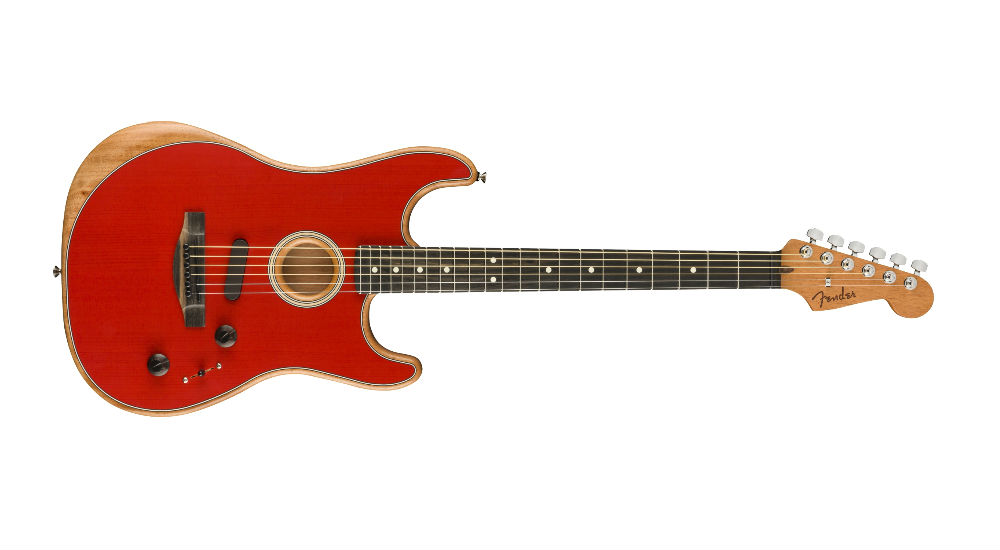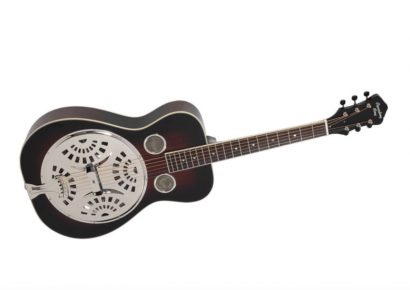However, when Fender debuted the Acoustasonic Stratocaster at NAMM – and then shipped one directly to my desk a mere week later – I must profess to being quite curious. Wary, but curious nonetheless. Familiarity is something I tend to crave in a new instrument, so as a lifelong Strat player, I knew I’d be in my comfort zone with the Acoustasonic.
Although its body does look a bit awkward, it’s a surprisingly nice feeling guitar, with the breezy weight, meticulous contours and familiar Deep C neck profile making for quite a comfortable playing experience. This is due in part to the Acoustasonic’s classic combination of mahogany, ebony and Sitka spruce, and while the Dakota Red finish initially came across as a little too Wiggle-ish for my tastes, I forced myself to embrace my inner Murray and accept that it was actually kind of cool.
I’m going to dive straight in and say this: the Acoustasonic Stratocaster doesn’t deliver a tonne of volume or resonance. It does project a sweet midrange and sounds crisp when fretting up the neck, and the mahogany construction makes for a pleasantly warm tone, but the quaint soundhole and slimline body definitely hinders the overall projection and dulls the low-end response you’d expect from an acoustic. Unless you’re going for a particularly thin and twangy tone, I can’t imagine this would make for a flattering recording experience when mic’d up.
That being said, the Acoustasonic is still an incredibly fun guitar to play unplugged. The neck is ultra-responsive to slick single note runs, bluesy bends and jazzy comping, and there’s a surprising amount of overtones that pop out when strumming barre chords. It’s also a sublime fingerpicker too, particularly if you’re keen on those twangy, rootsy styles that so often beg for a Stratocaster. At times, I even forgot that I was playing an acoustic, which begs the question: who exactly are Fender trying to appeal to here?
Plugged in, however, the Acoustasonic Stratocaster is a whole new kettle of fish. Fender have obviously put a lot of work into the electronic design of the Acoustasonic Stratocaster to differentiate it from that of the Telecaster and ensure it’s as practical as can be. There’s a Fishman piezo pickup underneath the bridge saddle, as well as an internal Fishman body sensor pickup and a Fender N4 magnetic noiseless pickup near the bridge position. The impressive Acoustic Engine allows you to flick between five classic acoustic body and wood types via the selector switch, while the Mod knob lets you select and blend between different voicings from each pickup to unlock a broad spectrum of tones.
This sounds a little naff when explained, but in action, it’s actually pretty impressive; whether you’re gunning for a beefy dreadnaught tone, the warmth of an orchestral model or even just a gritty electric sound, it’s all easy to achieve with the Acoustasonic Stratocaster. I tested a whole bunch of tonal combinations through a PA, straight into an amplifier and even through a long and winding pedal chain, and experienced nothing I could say wasn’t applicable to a live or studio setting.
Sure I had my doubts about this guitar, but in the end, Fender knocked them right on the head: the Acoustasonic Stratocaster is a guitar that really puts fun to the forefront. It’s a comfortable, super-playable and very forward-thinking instrument, and while it’s a little underwhelming unplugged, it’s a sheer wonder to hear its sounds when amplified. I guess the old adage is right: never judge a book by its cover.

